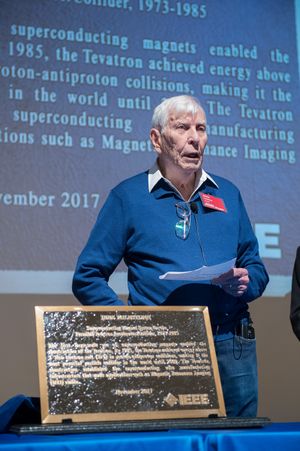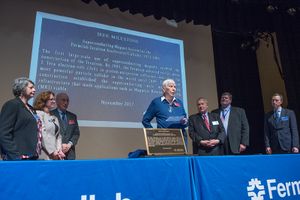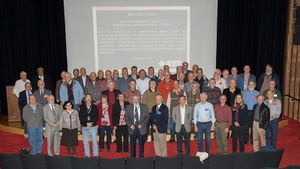Milestones:Superconducting Magnet System for the Fermilab Tevatron Accelerator/Collider, 1973-1985
Title
Superconducting Magnet System for the Fermilab Tevatron Accelerator/Collider, 1973-1985
Citation
The first large-scale use of superconducting magnets enabled the construction of the Tevatron. By 1985, the Tevatron achieved energy above 1 Tera electron-volt (TeV) in proton-antiproton collisions, making it the most powerful particle collider in the world until 2009. The Tevatron construction established the superconducting wire manufacturing infrastructure that made applications such as Magnetic Resonance Imaging (MRI) viable.
Street address(es) and GPS coordinates of the Milestone Plaque Sites
The Milestone Plaque is mounted inside Wilson Hall on the fifteenth floor, at Fermi National Accelerator Laboratory, at a location where the entire 4-mile circumference Tevatron main ring can be seen.
Fermi National Accelerator Laboratory Kirk and Pine Roads Batavia, Illinois 60510
Wilson Hall can be prominently seen from all roads on the laboratory site. The exact address of Wilson Hall is at the intersection of Kautz Rd. and Road A. The GPS coordinates are latitude 41.83856, longitude -88.26224 in decimal degrees., 41.83856, -88.26224
Details of the physical location of the plaque
The Milestone Plaque will be mounted inside Wilson Hall on the fifteenth floor, at Fermi National Accelerator Laboratory. The fifteenth floor has windows on all sides for viewing the Fermilab site. The mounting will be affixed to the permanent concrete structure of the building, at a location where the entire 4-mile circumference Tevatron main ring can be seen.
How the plaque site is protected/secured
Fermi National Accelerator Laboratory is a government owned contractor operated national laboratory. Visitors will have free access to the site where the Milestone Plaque will be mounted, subject to the usual regulations for access to government owned sites. For most security conditions, a photo identification is sufficient to obtain access to the Milestone Plaque site.
Historical significance of the work
The Tevatron was the first particle-physics machine to use superconducting magnets as a main component [1]. The ability of the superconducting wire to carry electrical currents far above the capacity of ordinary copper wires, and do so without generating heat, provided the means to sustain magnetic field strengths more than double what could be achieved with copper-iron electromagnets. The Tevatron’s dipole magnets operated at 4.2 tesla during long storage periods when particle collisions were occurring [2]. Arrangement of these magnets in a ring 4 miles in circumference created a synchrotron powerful enough to produce proton-antiproton collisions in excess of 1 tera-electronvolt, TeV, in energy, hence the name “Tevatron”. For more than 2 decades, the Tevatron was the only machine on Earth capable of producing this collision energy, until eclipsed by the Large Hadron Collider in 2009 [3].
Like other particle colliders, the purpose of the Tevatron was to discover new fundamental particles and gain understanding about the origins of energy and forces. When the Tevatron was constructed, the list of fundamental particles that make up the Standard Model of Particle Physics, also called the Standard Model, was incomplete, with many of its fundamental components predicted by theory but not measured or observed directly. Discovery of the Top Quark in 1995 [4], high-precision data about physical processes involving quarks, and observation of other particles made of multiple quarks solidified the theoretical predictions of the Standard Model.
Features that set this work apart from similar achievements
The Tevatron was also the first large-scale application of mass-produced superconducting magnets. Over 1,000 magnets were built, tested, and installed in the main ring [2,5]. At the time of the Tevatron’s construction, manufacturing of the copper-clad, niobium-titanium alloy superconducting wire was on a scale of hundreds of kilograms. The Tevatron required approximately 200 metric tons, i.e. 200,000 kilograms, of conductor [2], establishing a record as the world’s largest procurement of superconducting wire at that time [6]. This necessitated the development of large-scale infrastructure in industries associated with wire manufacture, including raw materials refining, ingot melting, composite material extrusion, and wire drawing. The scale-up of manufacturing also instigated other changes associated with performance, reliability, and cost [7]. These changes enabled commercial applications that rely upon superconducting magnets, such as magnetic resonance imaging (MRI) devices, to obtain low-cost, reliable wire. Later particle accelerators relied upon this same infrastructure or its direct descendants for superconducting wire manufacture.
Significant references
The full text of the supporting materials have been submitted to the staff of the IEEE History Center, and will be supplied to the advocate for reference.
[1] Edwards, Helen T. "The Tevatron energy doubler: a superconducting accelerator." Annual Review of Nuclear and Particle Science 35.1 (1985): 605-660.
[2] Orr, J. R. "Status of the energy saver." IEEE Transactions on Nuclear Science 30.4 (1983): 1967-1969.
[3] "LHC sets new world record" (Press release). CERN. 30 November 2009.
[4] “Physicists discover top quark” (Press release). Fermilab. 2 March 1995; Abe, F., et al. "Observation of top quark production in p p collisions with the collider detector at Fermilab." Physical Review Letters 74.14 (1995): 2626.
[5] Cooper, W.E. Fisk, H., Gross, D., Lundy, R., Schmidt, E., Turkot, F. “Fermilab Tevatron Quadrupoles”, IEEE Transactions on Magnetics 19.3 (1983) 1372-1377.
[6] Tollestrup, Alvin V. "The Tevatron Hadron Collider: A Short History." NATO ASI SERIES B PHYSICS 352 (1996): 499-524.
[7] Cooley, L. D., A. K. Ghosh, and R. M. Scanlan. "Costs of high-field superconducting strands for particle accelerator magnets." Superconductor Science and Technology 18.4 (2005): R51.
[8] Kerst, D. W., et al. "Attainment of very high energy by means of intersecting beams of particles." Physical Review 102.2 (1956): 590.
[9] Proc. Brookhaven Summer study on storage rings, accelerators and experimentation at super-high energies, BNL-7534, Brookhaven National Lab, Upton, New York (1963) (Note: this document is very large 64k, and will be made available to the advocate using a dropbox.)
[10] Hahn, H., M. Month, and R. R. Rau. "Proton-proton intersecting storage accelerator facility ISABELLE at the Brookhaven National Laboratory." Reviews of Modern Physics 49.3 (1977): 625.
[11] Walters, C. "Magnetization and design of multistrand superconducting conductors." IEEE Transactions on Magnetics 11.2 (1975): 328-331.
[12] Palmer, R., and A. V. Tollestrup. "Superconducting magnet technology for accelerators." Annual Review of Nuclear and Particle Science 34.1 (1984): 247-284.
Supporting materials
See references
Map


